Papers by Jonny Everson Pereira
Ciência e …, 2007
... P. 321 - 69908-970 - Rio Branco, AC - Bolsista em Produtividade do CNPq - jonny@cpafac. embra... more ... P. 321 - 69908-970 - Rio Branco, AC - Bolsista em Produtividade do CNPq - jonny@cpafac. embrapa.br. RESUMO. ... In: Congresso Brasileiro de Fruticultura, 13., 1994, Salvador. Anais...Salvador: Associação Brasileira de Fruticultura, 1994. p. 1113-1114. [ Links ]. ...
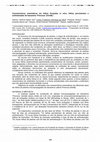
No processo de micropropagacao de plantas, a etapa de aclimatizacao e, na maioria das vezes, cons... more No processo de micropropagacao de plantas, a etapa de aclimatizacao e, na maioria das vezes, considera limitante e pode ocasionar elevado indice de perdas. Isso porque a transferencia abrupta das plantas de um local com condicoes controladas ( in vitro ) para casa de vegetacao ou telados pode provocar acentuada transpiracao, principalmente dos orgaos aereos, o que tem sido atribuido as alteracoes anatomicas e fisiologicas induzidas pelas condicoes peculiares dos recipientes de cultivo. Alem disso, as folhas e raizes formadas in vitro sao consideradas pouco funcionais, nao garantindo uma satisfatoria taxa fotossintetica e absorcao de agua e nutrientes. Portanto, torna-se imprescindivel submeter as plantas micropropagadas a gradual aclimatizacao, anteriormente o trasplantio para o campo, pois os novos orgaos formados terao essas alteracoes corrigidas. De acordo com Sandoval et al. (1994), embora as modificacoes induzidas in vitro perdurem ate os primeiros dias apos a transferencia da...
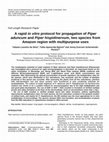
African Journal of Biotechnology, 2012
The morphogenic potential of nodal explants of Piper aduncum and Piper hispidinervum (Piperaceae)... more The morphogenic potential of nodal explants of Piper aduncum and Piper hispidinervum (Piperaceae) was investigated and a protocol for rapid micropropagation is described. An experiment based on the saline formulation of Murashige and Skoog (MS) and Wood Plant medium (WPM) combined with different N6-benzylaminopurine (BAP) and 1-naphthalene acetic acid (NAA) concentrations was evaluated. After determining the optimal concentration of growth regulators, the multiplication rates for the species, which were distributed in five subcultures, was assessed, and the number of plantlets produced in this period was recorded. After assessing the plants from all five subcultures, plantlets with well-developed root and shoot systems were transferred to pots containing substrate for acclimatization. The culture of nodal segments of P. aduncum and P. hispidinervum on hormone-free medium was shown to be a suitable method for micropropagation due to the high multiplication rate and good plant development. The use of BAP or BAP + NAA resulted to formation of vitrified multiple shoots and callus formation at the base of the microcuttings. Even at concentrations lower than 1 mg L-1 , the use of BAP resulted in vitrified multiple shoot and callus formation, without significantly improving the multiplication rates. For both species, the first subculture resulted in the greatest number of axillary buds, and mainly for P. hispidinervum, the MS medium was the most appropriate for in vitro multiplication of microcuttings. The species showed 100% root formation, and acclimatization of plants from the fifth subculture in a greenhouse resulted in 100% survival.

Journal of Proteomics, 2020
In this study, we evaluated the potential use of MALDI-TOF MS Profiling for the differentiation o... more In this study, we evaluated the potential use of MALDI-TOF MS Profiling for the differentiation of biological samples submitted to different treatments. We compared the bacterium Xanthomonas campestris pv. campestris (Xcc), grown in culture medium and in vivo (recovered from the plant). Plant samples were also analyzed and included explants at different somatic embryogenesis (SE) stages, as well as leaves from Brassica oleracea and Arabidopsis thaliana inoculated with Xcc, at different time points. The results showed that bacteria and highly divergent plant samples, such as those from embryogenic stages, can be unequivocally differentiated and the clustering was in accordance with proteomic analysis performed by 2-DE. These results show an important application of MALDI-TOF MS Profiling to select and prioritize samples to be analyzed prior to more complex approaches including transcriptomics and proteomics. We also show that in plant-pathogen interactions, when more subtle differences are obtained, the main contribution of MALDI-TOF MS Profiling is in the assessment of experimental variability. This is relevant since reproducibility is a challenging issue when dealing with complex experimental conditions such as plant-pathogen interactions. We propose the use of MALDI-TOF MS Profiling to aid researchers in minimizing experimental variability unrelated to the condition being analyzed. SIGNIFICANCE: MALDI-Profiling offers an inexpensive, rapid and reliable approach for investigating the protein profile to assess sample differentiation and experimental variability in microorganisms and plants and can be highly useful to analyze samples prior to more complex and expensive techniques such as proteomics and transcriptomics.
Pesquisa Agropecuária Brasileira, 2017
The objective of this work was to evaluate the micropropagation of blackberry (Rubus spp.) cultiv... more The objective of this work was to evaluate the micropropagation of blackberry (Rubus spp.) cultivars, after in vitro conservation under minimal growth conditions. Nodal segments of the 'Guarani', 'Caingangue', 'Ébano', and 'Xavante' genotypes were conserved under minimal growth conditions at 20ºC, for 15 months. Microshoots were regenerated and multiplied by up to five successive subcultures, when they were rooted and acclimatized. After 30 days of acclimatization in a greenhouse, rooted plantlets showed no significant losses. Blackberry cultivars can be conserved in vitro for 15 months, without subcultures and, after this time, they can be micropropagated on a large-scale, maintaining the regenerative potential and multiplication.

Pesquisa Agropecuária Tropical, 2019
The bamboo species Guadua magna and G. angustifolia have been propagated nearly exclusively by co... more The bamboo species Guadua magna and G. angustifolia have been propagated nearly exclusively by conventional techniques of vegetative propagation. Micropropagation is a promising technique and an alternative to conventional ones. This study aimed to micropropagate plants, estimate the plantlets production and analyze the genetic fidelity of G. magna and G. angustifolia by ISSR molecular markers. Mother plants of both species were cultivated in a greenhouse, and either sprayed or not with fungicide. In the laboratory, microcuttings were disinfested and established in MS culture medium with 3.0 mL L-1 of Plant Preservative Mixture (PPM®) and 1 mL L-1 of Carbendazin®. The contamination-free shoots were multiplied in liquid or semi-solid MS medium with 3.0 mg L-1 of BAP for five subcultures. Rooting was performed in liquid or semi-solid MS1/2 medium, plus 3.0 mg L-1 of IBA. Acclimatization was performed on a commercial substrate, in a growth chamber, and the genetic fidelity of the clone...

Journal of proteomics, Jan 5, 2018
Oil palm is an oleaginous plant of relevant economic importance since its fruits are rich in vege... more Oil palm is an oleaginous plant of relevant economic importance since its fruits are rich in vegetable oil. These plants have a single apical meristem and the main method for vegetative propagation is somatic embryogenesis. The aim of this study was to identify differentially abundant proteins from oil palm genotypes contrasting in the capacity of embryogenic competence acquisition, using shotgun proteomics. Oil palm leaves were subjected to callus induction and the material was collected in biological triplicates at 14 and 90 days of callus induction. LC-MS/MS analysis was performed and revealed a total of 4695 proteins. Responsive and non-responsive genotypes were compared at 14 and 90 days of callus induction and 221 differentially abundant proteins were obtained. The data analysis revealed several proteins mainly related to energy metabolism, stress response and regulation of cell cycle, further analyzed by qRT-PCR, which seem important for embryogenic development. We suggest so...

3 Biotech, 2018
Several biochemical components associated with different stages of somatic embryogenesis in coffe... more Several biochemical components associated with different stages of somatic embryogenesis in coffee ( L.) are investigated using foliar explants. Soluble sugar, starch, free amino acids and total proteins were extracted and quantified at different stages of somatic embryogenesis, such as foliar segments (initial explants), primary calluses, embryogenic calluses, globular embryos, torpedoes, cotyledonary embryos and mature fruit zygotic embryos. Total soluble sugar levels increased sixfold at the initial stages of somatic embryogenesis induction. During this period, total soluble sugar in the cultures contained approximately 99.3% glucose and fructose. At 67.4 μg/mg MS, no significant changes were observed in total sugar content during the embryo's somatic maturation and regeneration. During this stage, total soluble sugar was composed of 60% sucrose. After primary callus formation, starch contents increased gradually until the culture's conclusion. Total free amino acids, par...

Scientia Horticulturae, 2017
Syagrus oleracea (Mart.) Becc. is a palm tree (Arecaceae) indigenous to Central and Eastern Brazi... more Syagrus oleracea (Mart.) Becc. is a palm tree (Arecaceae) indigenous to Central and Eastern Brazil. Its cultivation is projected as an excellent option for income diversification, based on the wide range of products that can be exploited, with an emphasis on the characteristic bitter-tasting hearts-of-palm. Due to its increasing economic importance, combined with the extractive exploitation of the species and the indiscriminate advance of deforestation in the region where the species is found, it is necessary to develop studies and technologies, including taxonomic and systematic characterization (morphological, phenotypic, molecular, chemical and reproductive), conservation of germplasm, and selection of superior genotypes, as well as to develop efficient propagation methods, in order to ensure conditions for the continuous and future development of genetic improvement efforts. Although it is a palm tree that is already cultivated, and with economic potential, this crop presents a significant deficit of technical-scientific knowledge at different points of its productive chain. Scientific studies and publications referring to the species are scarce, with a significant proportion of the literature written in Portuguese. The aim of this review is to compile the available information about the species, addressing several aspects of the plant and its potential applications, in order to increase its visibility on the part of different research groups.

Acta Scientiarum. Agronomy, 2016
The objective of this work was to characterize the biochemically systemic bacterial isolated from... more The objective of this work was to characterize the biochemically systemic bacterial isolated from banana plants, to evaluate the bacterial sensitivity to antibiotics, and to determine the phytotoxicity of banana shoots during in vitro proliferation. Systemic bacteria belonging to the Klebsiella and Aeromonas genera were isolated from the “Maravilha” (FHIA 01 AAAB), “Preciosa” (PV 4285 AAAB) and “Thap Maeo” (AAB) varieties and were then characterized. Tests of shoot sensitivity to antibiotics were performed, and the minimum inhibitory concentration (MIC) and phytotoxic effects of selected antibiotics to plants were determined. Among the 20 antibiotics evaluated, the strains showed sensitivity to cefaclor, cefalexin, cefalotin, nalidixic acid, chloramphenicol, and vancomycin. However, during MIC determination, the best results were obtained with cefaclor, vancomycin or nalidixic acid alone in concentrations ranging from 512 to 1,024 mg L-1. In culture medium, cefaclor at 1,024 mg L-1 ...
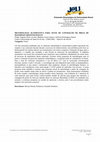
Scientia Agricola, 1998
Uma metodologia alternativa para o teste de tetrazólio, evidenciou a possibilidade de redução do ... more Uma metodologia alternativa para o teste de tetrazólio, evidenciou a possibilidade de redução do período de embebição (pré-condicionamento) das sementes de 16 horas à 25ºC para 6 horas à 41ºC. Como a metodologia foi testada, até o momento, em um número limitado de cultivares, permaneceu a dúvida se o procedimento alternativo (6h/41ºC) era aplicável para uma gama maior de cultivares de soja. Assim sendo, executou-se a presente pesquisa onde foram avaliados três períodos de embebição (4h, 6h e 16 horas), duas temperaturas (41ºC e 25ºC) em sementes das cultivares BR-13, EMBRAPA 4, EMBRAPA 48, FT-Abyara, FT-5, IAS 5, OCEPAR 13, OCEPAR 14, OCEPAR 16 e OCEPAR 17. Os seguintes testes foram realizados: grau de umidade e tetrazólio (determinando-se os índices de vigor, viabilidade, dano mecânico, deterioração por umidade e lesão de percevejo). Concluiu-se que: a) o pré-condicionamento das sementes de soja à temperatura de 41ºC por 6 h possibilitou o desenvolvimento de coloração nítida para a...

In Vitro Cellular & Developmental Biology - Plant, 2014
In vitro conservation techniques can be utilized for germplasm maintenance. However, few reports ... more In vitro conservation techniques can be utilized for germplasm maintenance. However, few reports on the in vitro conservation of sugarcane species are present in the literature. The objective of this study was to subject sugarcane plants to in vitro under minimal growth conditions and to evaluate the survival, regeneration, and the monitoring of nuclear DNA content levels of the plants. Shoots from 10 sugarcane varieties (Saccharum spp.) were introduced into two media: MC1, consisting of half-strength Murashige and Skoog (MS) salts and 3% sorbitol, or MC2, similar to the first formulation, but additionally supplemented with 3.8 μM abscisic acid (ABA). The shoots were maintained for up to 12 mo at 18°C in the presence of light. At the end of the period, the explants were inoculated onto multiplication medium containing 0.9 μM 6benzylaminopurine (BAP) and 0.47 μM kinetin (Kin) for growth recovery. Flow cytometry analysis of shoots was verified at every 6 mo of storage. As a result, we found distinct behaviors of the varieties studied over the storage time, but in general, MC1 provided the greatest explant survival rates, with an average of approximately 80% cultures being able to recover. Once in the recovery media, the explant regrowth was fast, and the ability to multiply shoots was reestablished from the second 30-d subculture. However, by flow cytometry analysis, we observed a decrease in the estimated relative amount of DNA at 12 mo storage for most varieties examined, which was not observed when the monitoring was done at 6 mo. From these results, we conclude that sugarcane plants survived the minimal growth condition; however, maintaining the genotypes for extended periods in vitro may lead to variations in the estimated amount of nuclear DNA and, thus, be at risk of somaclonal variation.

Revista Brasileira de Fruticultura, 2011
RESUMO-Altos custos de produção geralmente limitam o uso comercial da micropropagação. O uso de m... more RESUMO-Altos custos de produção geralmente limitam o uso comercial da micropropagação. O uso de meios de cultura líquidos é considerado uma solução para a automação e redução de custos. Entretanto, dependendo da cultivar de bananeira, esse processo pode mostrar diferentes níveis de dificuldade, e adaptações nos protocolos são necessárias. Neste estudo, experimentos de diferenciação celular e regeneração de plantas foram desenvolvidos em células em suspensão de banana pela avaliação da densidade inicial de células, meios de cultura e sistemas de imersão temporária. Para tanto, uma sequência de três experimentos foi realizada: o primeiro avaliou os efeitos da densidade celular (0,5; 1 e 2 mL), meios de cultura (M1: 1/2MS, 0,1 g.L-1 de ácido ascórbico, 0,1 g.L-1 de L-prolina, 30 g.L-1 de sacarose e 10 µM de 2iP; M2: MS, 30 g.L-1 de sacarose, 2,2 µM de BAP e 11,4 µM de AIA) e períodos de diferenciação celular (40 e 130 dias); o segundo experimento analisou o efeito do tamanho dos propágulos diferenciados em meio líquido (aprox. 2,5; 5 e 10 mm em diâmetro) na formação de embriões somáticos ou na regeneração de plantas; finalmente, um terceiro experimento avaliou o efeito de sistemas de cultivo com papel-filtro cobrindo o meio de cultura semissólido e sistemas de imersão temporários na diferenciação dos propágulos e na regeneração de plantas. Não foram observadas diferenças significativas entre os meios de diferenciação, porém as melhores diluições de células para a diferenciação foram de 1 e 2 mL/30mL de meio de cultura, enquanto diluições de 0,5 mL/30 mL de meio aumentaram a oxidação celular. A extensão do período de diferenciação de 40 para 130 dias foi importante para produzir maior número de calos/propágulos uniformes e com pelo menos de 10 mm de diâmetro, que puderam ser usados em sistemas de imersão temporária (biorreatores) para a diferenciação de embriões somáticos e regeneração de plantas. Considerando todos os sistemas de regeneração, verificou-se que o uso de meios de regeneração de consistência semissólida com papel-filtro na superfície do meio é o mais responsivo para a diferenciação de embriões somáticos e regeneração de plantas. Termos para indexação: Musa spp., cultura de células, diluição celular, embriogênese somática, micropropagação. CELL DIFFERENTIATION AND PLANT REGULATORS ON BANANA ABSTRACT-High production costs generally limit the commercial use of the in vitro micropropagation. The use of liquid media is considered to be the ideal solution for the automation and the production costs reduction. However, depending on the variety, this process can show different levels of difficulty and adaptations in protocols are needed. In this study experiments on cell differentiation and plant regeneration were carried out from banana cell suspension culture, by evaluating the initial cell density, the culture media and the temporary immersion systems. A sequence of three experiments was performed: the first one evaluated the effects of cell density (0.5; 1 and 2), culture media (M1: 1/2MS, 100 g.L-1 ascorbic acid, 100 mg.L-1 L-proline, 30 g.L-1 sucrose and 10 µM 2iP; M2: MS, 30 g.L-1 sucrose, 2,2 µM BA and 11,4 µM IAA) and the period of cells differentiation (40 and 130 days). The second one analyzed the effect of propagules size

Brazilian Journal of Plant Physiology, 2010
Changes in the leaf structure of plants grown in different conditions have been reported, such as... more Changes in the leaf structure of plants grown in different conditions have been reported, such as increase in size and density of stomata and reduction in stomatal control, amount of epicuticular wax, and mesophyll thickness, with a high diversity of intercellular spaces. However, these changes are highly variable depending on the physiological and morphological characteristics of each species. The objective of this work was to analyze the adaptability and anatomical plasticity of oil palm seedlings produced after embryo rescue and pre-germinated seeds. Expanded leaves were prepared for evaluation of morphometric data and anatomical structures. It was verified that the environmental conditions in vitro negatively influenced the stomata density, epidermal and hypodermal thickness, and the values for the expansion cells and leaf mesophile. Anatomically, the oil palm leaves present the same tissues composition in both growth conditions, with uniseriate epidermal cells, and tetracitic s...
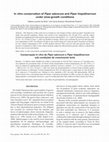
– The objective of this work was to evaluate in vitro storage of Piper aduncum and P. hispidinerv... more – The objective of this work was to evaluate in vitro storage of Piper aduncum and P. hispidinervum under slow-growth conditions. Shoots were stored at low temperatures (10, 20 and 25°C), and the culture medium was supplemented with osmotic agents (sucrose and mannitol – at 1, 2 and 3%) and abiscisic acid – ABA (0, 0.5, 1.0, 2.0 and 3.0 mg L-1). After six-months of storage, shoots were evaluated for survival and regrowth. Low temperature at 20oC was effective for the in vitro conservation of P. aduncum and P. hispidinervum shoots. In vitro cultures maintained at 20oC on MS medium showed 100 % survival with slow-growth shoots. The presence of mannitol or ABA, in the culture medium, negatively affected shoot growth, which is evidenced by the low rate of recovered shoots. Index terms: ex situ conservation, germplasm bank, micropropagation. Conservação in vitro de Piper aduncum e Piper hispidinervum sob condições de crescimento lento Resumo – O objetivo deste trabalho foi avaliar a cons...
O presente trabalho objetivou avaliar respostas de genitores Pisifera quanto a aquisicao de compe... more O presente trabalho objetivou avaliar respostas de genitores Pisifera quanto a aquisicao de competencia embriogenica e posterior regeneracao de clones por embriogenese somatica.
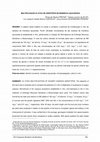
O objetivo deste trabalho foi avaliar e comparar o potencial de multiplicacao in vitro deacessos ... more O objetivo deste trabalho foi avaliar e comparar o potencial de multiplicacao in vitro deacessos de mandioca acucarada. Foram utilizadas microestacas de dez acessos de mandiocaacucarada ja estabelecida in vitro, pertencentes a Colecao de Germoplasma da Embrapa RecursosGeneticos e Biotecnologia. O meio de cultura utilizado foi formado pelos sais e vitaminas de MSadicionado de 100 mg.L-1 de tiamina, 10 mg.L-1 de inositol, 20 g.L-1 de sacarose e os reguladores decrescimento BAP, ANA e AG3 nas concentracoes de 0,02 mg.L-1, 0,01 mg.L-1 e 0,01 mg.L-1,respectivamente. Apos 40 dias de cultivo foram analisados os resultados de altura, numeros degemas e numero de raizes em relacao a posicao da gema (apical e axilar) no inicio do cultivo.Verificou-se que na media, genotipos multiplicados a partir de explantes apicais apresentaram altura,numero de gemas e numero de raizes formadas de 3,2 cm; 3,7 e 3,2 respectivamente, valoressignificativamente superiores aqueles observados para as plantas origi...

Seed Science and Technology, 2017
Knowledge of the seed storage behaviour of a species is essential for germplasm preservation. The... more Knowledge of the seed storage behaviour of a species is essential for germplasm preservation. The babassu (Attalea speciosa) is a palm from north and northeast regions of Brazil. The oil extracted from the seeds of this species has a range of applications. To date, the storage behaviour for A. speciosa, as well as its minimum storage conditions, have not been determined and hence determination of seed storage behaviour was the objectives of this work. The ability to germinate as seed moisture content was reduced over eight days was followed. Seeds at 5% water content were then stored at four temperatures (-196,-20, 6 and 25°C) and over three time periods (0, 180 and 360 days). Germination tests were performed by the cultivation of zygotic embryos in vitro. There was a significant decrease in germination of the seeds stored at 25°C after 360 days, whereas there was no reduc tion in germination of seeds stored at-20 and-196°C. The results from this study suggest that A. speciosa seeds tolerate desiccation below 5% and storage at low temperature, and therefore present orthodox storage behaviour.











Uploads
Papers by Jonny Everson Pereira